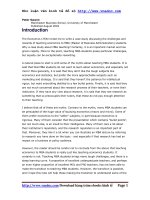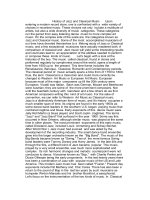classical economics
Bạn đang xem bản rút gọn của tài liệu. Xem và tải ngay bản đầy đủ của tài liệu tại đây (6.44 MB, 46 trang )
Chapter 7: Classical
Economics
The Economy at Full
Employment
Issues in 2006 for the Midterm
Elections
How does increased immigration affect wages and
the level of output in the economy?
What are the benefits of increased investment?
What happens to wages, jobs, GDP if employers
must pay higher taxes for hiring labor?
If our government spends more, does this mean
we must have a lower level of consumption or
investment in the economy?
Classical Economics
A school of thought
that provides insights
into the economy
when it operates at or
near full employment.
Supply-Siders
Economists /
politicians who
emphasize the role of
taxation for
influencing economic
activity.
Favored by the
Republican Party
New School: Real Business
Cycle Theory
Tries to explain why
there are booms and
busts in the economy.
REMEMBER!
With the classical
model, wages and
prices are assumed to
adjust freely and
quickly according to
the laws of supply
and demand.
No Keynsian price
controls
KISS: What determines output?
Stock of Capital (K)
Labor (L)
The total of all machines,
equipment and buildings in
the economy.
The total effort of all
employed workers in an
economy
Y = F(K,L)
Y = Income = GDP
Y = F (K,L)
Aggregate Production
Function: How much
output is produced
from the inputs of
capital or labor.
More inputs of either
leads to increased
output.
Could this be a factor in
the immigration battles?
Aggregate Production Function
In most situations we
assume capital is
fixed at a constant
level!
LABOR is the only
variation that changes
the level of output in
the economy!
SO: What is the relationship
between labor and Output?
If capital is fixed?
Increases at a
decreasing rate.
WHY?
See page 133 for
graph 7.1
Principle of Diminishing Returns
Suppose that output is produced with two
or more inputs and that we increase one
input while holding the other inputs fixed.
Beyond some point – called the point of
diminishing returns – output will increase
at a decreasing rate.
See pgs. 133 - 135
Short-Run Production Function
Show how much
output is produced
when capital stock is
constant and labor
varies.
The Demand and Supply of Labor
Firms hiring depends
on the REAL WAGE.
The wage paid to
workers adjusted for
changes in prices.
What determines the
REAL WAGE?
The Marginal Principle
determines the Real Wage
Marginal Benefit >
Marginal Cost
Marginal Cost >
Marginal Benefit
Increase level of
activity
Reduce activity
Marginal Cost =
Marginal Benefit
IDEAL!
Huh!?
Marginal Benefit:
Benefit a firm
receives from hiring
an additional worker
is the VALUE of the
EXTRA OUTPUT
from the hiring.
Huh?!
Marginal Cost: Is the
REAL WAGE a firm
pays to hire the
additional worker
See page 135 for
wage scenario.
Here’s the Payoff
If real wages fall, then
MB > MC and more
people can get
employed.
Is that why some
politicians / employers
favor undocumented
workers?
Changes in Real Wages Affect
Workers Two Ways:
SITUATION: Workers
have to decide how
many hours they want
to work and how
much leisure time
they want.
#1 Way: Increasing Real Wages
Make working more
attractive and raise
the opportunity costs
of NOT working.
SUBSTITUTION
EFFECT: Substitution
of work for leisure
time.
#2 Way: Raising Real Wages
Higher wage raises
workers income for
the same hours
worked. Workers
may choose more
leisure over work.
INCOME EFFECT:
Leads to decreased
supply of labor.
Substitution Effect v. Income
Effect
Do NOT work
together.
See pages 136 – 137
scenarios.
Capital Stock Changes?
Marginal Benefit for
hiring workers
increases.
Workers are becoming
more productive with
the additional capital.
Labor Market Equilibrium and Full
Employment
Read scenario pg.
138 - 139
SO: Y = F (K,L)
Potential output increases
as the supply of labor
increases or the stock of
capital increases.
Liberal immigration plans
will shift the labor curve
RIGHT and lead to higher
level of employment.
OUTPUT increases.
Investors are
happy
Voters are
happy
Make sure to read
VARIATIONS IN LABOR
SUPPLY
Page 140.









